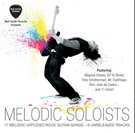Vibrato Control

I believe that the best and most expressive vibrato is slow to moderate in speed but wide in range. There are times, however, when a somewhat narrower range is needed (usually over slow and soft musical passages). A fast vibrato can sometimes be effective, but use it with caution as it can lead to an out of control sound (and an out of tune sound if you are not careful). I very rarely use a fast or narrow vibrato and my vibrato is never fast and narrow at the same time!
Here are the most common problems that many inexperienced guitarists have with their vibrato technique:
- The vibrato is too fast. This sounds like a small annoying insect buzzing around your ears, and the note usually sounds out of control.
- The vibrato is too narrow in range. Unless you are playing in a slow and soft musical passage, this makes the note your playing sound weak and timid.
- Vibrato is not used enough. Notes decay too quickly and sound lifeless. This can cause the end of musical phrases to sound boring.
- Vibrato is being over used. Some players try to cram in vibrato at every possible chance they can. Overuse tends to lose its effectiveness on the listener.
- Vibrato is used either poorly or not at all on bent notes. When a string is bent the note will naturally decay more quickly without a strong vibrato to support it. If you don’t already know this, adding vibrato to a note (especially a bent note) can drastically increase the life and sustain of the pitch.
- The vibrato is not in tune! (This one sounds really awful!) This is a common problem on bent notes
and is caused by inconsistent bending of the string by the left hand (or the right hand if you play a left handed guitar. You must be careful to make sure that the string is being bent to the same place every time otherwise the pitch will be inconsistent and out of tune. Another cause of the note sounding out of tune is that the bent note is not being released (after each time that it is bent during the vibrato motion) to the exact same pitch every time. If you have this problem and are having a hard time solving it, I recommend to practice using an electronic tuner that has needle meter. Watch the needle and make sure that you are bending and releasing the note to the same place every time. It will help if you do a slower vibrato while practicing with the tuner.
I highly recommend listening to players that have an impeccable vibrato technique. Here is a short list of virtuosos that have helped me to shape my own vibrato: Yngwie Malmsteen, George Bellas, Andy LaRocque (plays in the King Diamond band) and Jason Becker. There are, of course, other players who I think have excellent vibrato too – so here are a few more guitarist’s vibratos to listen for: John Petrucci, Marty Friedman, George Lynch and Eddie Van Halen (on the older Van Halen recordings). A great vibrato technique usually takes a long time to master. It wasn’t until after playing for many years that I felt that my own vibrato was where I wanted it to be. Finally, I’d like to suggest to you not to overlook or underestimate the importance and effectiveness of this highly expressive technique. Even after you master it, constantly work on it and continue to refine it always.
About The Author:
Tom Hess is a successful professional guitar player, composer and the guitarist of the band Rhapsody Of Fire. He also trains musicians to reach their guitar playing goals in his rock guitar lessons online. Visit his website, tomhess.net to read more articles about guitar playing, get free guitar tips and guitar playing resources.
Copyright 2002 by Tom Hess. All rights reserved.
(Used by permission)










